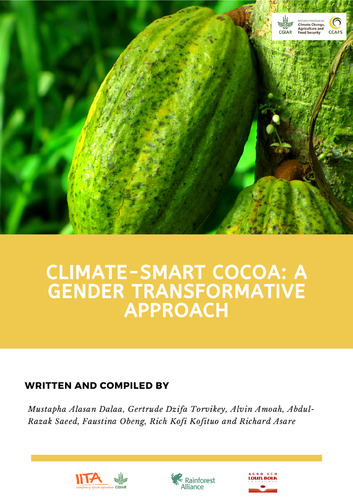Climate-Smart Cocoa: a gender transformative approach
Abstract
In general, government agricultural extension services were low or inadequate in many communities. Farmers reported not having adequate information on sound farm management practices and when they do come, they come in late. The gendered differences on access to information were also evident. Most people who access extension services were men with bigger cocoa farms. Women and youth receive less extension services which was attributed to their poor resource base.
Agricultural interventions were sometimes structured in ways that favour men with the unitary model of household logic which assumes that whatever the man learns will trickle down to the household. Meanwhile, the households themselves are spaces for the entrenchment of gender and generational ideologies and hierarchical power dynamics. The study found that in almost all communities, while older men favoured women’s involvement in decision making and for them to take control of cocoa related decision making, they only accepted this for instrumental reasons such as the benefits that the household will derive from it. Most importantly, many male youth disfavoured women’s participations in decision making. The reasons for these included the fact that women are made to help men and the labour intensiveness of cocoa production among others. This requires programmes that are modelled with a Gender Transformative Approach (GTA) framework that will tackle the individual level capacities, social relations and the inherent institutional rules of organisations that work in the cocoa sector.
Recommendations
i) Initiate programmes and campaigns that aim at behavioural change, especially targeting the discriminatory practices and patriarchal norms in communities. This means excavating traditional practices that promote equity and gender equality and combining these with modern ones. These messages should target specific constituencies such as youth who are more averse to women’s participation in decision making.
a) Initiate youth clubs where conversations are held about gender inequality and equity.
ii) Develop gender sensitive extension service and training programmes that take into account literacy levels of the various social groups, local farm management practices and indigenous knowledge.
a) Develop content in the Ghanaian languages spoken in the communities.
b) Design programmes in formats that are clear, concise, accessible, sensitive and friendly to farmers especially women and youth. This should include the use of multiple dissemination channels such as community information centres, Farmer Based Organisations (FBOs), info graphics, local radio, storytelling, community durbars, festivals, religious activities and theatre among others.
c) Integrate climate change and variability information in extension service delivery
iii) Initiate affirmative action programmes through ensuring that the leadership of producer-based organisations in communities have women in leadership positions.
iv) Promote safe traditional and modern savings and loans schemes to encourage savings and to enhance access to loans in times of shock.
a) Support local credit schemes with resources to function in ways that promote equity and equality. These should target women, youth, poorer farmers and other vulnerable social groups.
v) Design programmes that create a pool of labour-saving technologies in communities for easy access.
a) Identify agricultural and non-agricultural labour-saving technologies that are required in communities.
b) Identify ways in which access can be enhanced especially for women and youth.
c) Promote collective/group ownership of equipment and its management to ensure sustainability of the programmes.
vi) Design programmes that help free women and girls of reproductive roles so they can have enough time for productive activities and leisure.
a) Invest in basic social services such as water and energy in communities.
vii) Promote alternative on-farm and off-farm livelihood activities in farming communities through community-based discussion processes and skills development programmes. The programmes will promote reinvestment in cocoa production and vice versa.
a) Promote food crop production as part of agroecological practices.
b) Develop multiple clusters of livelihoods including animal rearing and crop production both in terms of intensification and extensification.
c) Design programmes that encourage processing and value addition on agriculture and non-agricultural products to improve earnings.
d) Create programmes that link rural producers to markets
viii) Advocate for higher producer price for cocoa to compensate for farmer’s investment in production.
ix) Design programmes that promote the health of farmers.

